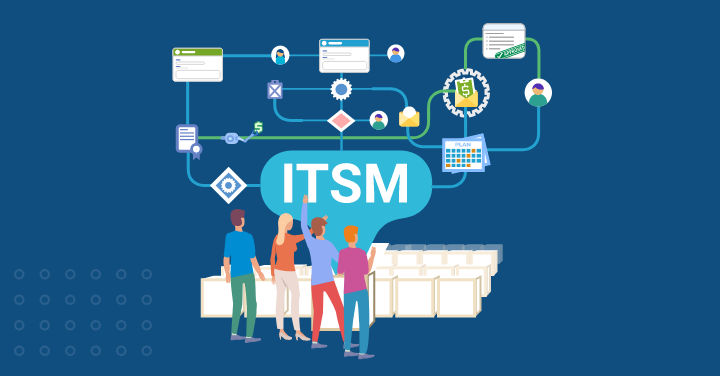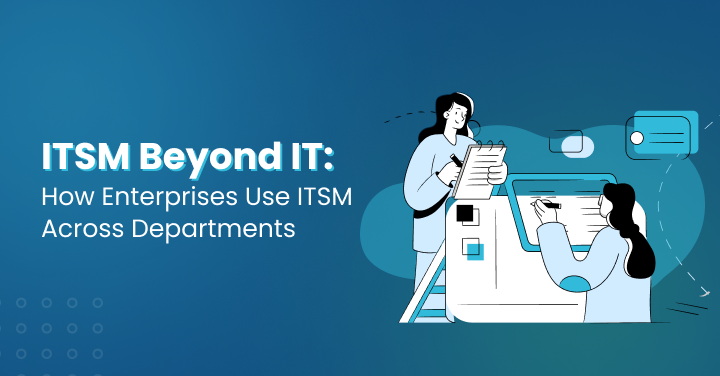Even the best IT projects may be derailed by ITSM problems, but people don’t talk about them until you’re already in the middle of implementation problems.
Using an IT Service Management framework may dramatically change how businesses provide and handle IT services. But a lot of businesses find that this change isn’t as easy as suppliers and advisors first said it would be.
ITSM is more than just a “nice to have” for IT departments, yet there are many things that may go wrong on the way to a successful ITSM deployment.
IT organizations that spend the right amount of money on ITSM solutions see better efficiency, more productivity, and stronger protection against threats.
Even while these are evident benefits, the truth is that many ITSM projects don’t achieve the business value they promised. Starting the ITSM implementation process without clear goals is one of the worst blunders that can be made.
In this essay, we’ll talk about the eight most typical ITSM mistakes that no one tells you about before you start implementing it.
If you know about these problems ahead of time, you’ll be better able to deal with them and make sure your ITSM project gives your organization the value it should.
Why Do ITSM Projects Commonly Fail?
ITSM projects often fail because of the different things that can go wrong in a company’s way of working or with their tech. One common mistake is not setting clear goals for the ITSM tool.
IT leaders need to be sure that the ITSM platform matches what the organization wants. This helps stop wasting money on special features that no one will use.
Also, when the group is not at a good point of ITSM maturity, it can be hard to bring all service desk agents together. If this happens, the team does not follow a service plan well and this can hurt service quality.
Another big problem is when the people who work at the service desk, or other IT staff, do not want to accept the changes. If there is not good talk about what the ITSM software or changes can do for them, teams do not care much.
This drop in care or engagement will slow down work. On top of that, if IT operations and main business function teams do not involve the right people, different groups find it difficult to work together and struggle to sustain ITSM projects.
Without real work at the start and honest talk, ITSM projects do not meet the organization’s goals. This means the group might miss their shot at improving their service delivery and making business outcomes better.
The Cost of Overlooking Pitfalls in ITSM Initiatives
Not taking care of common risks during ITSM initiatives can have big effects on your organization. If your IT support does not give steady service quality, your operations can get hurt. Bad risk management and not thinking about business needs may make service delivery get disrupted often. Then, your ITSM investment loses its value.
Impact of Pitfalls in ITSM Initiatives:
| Category | Issue |
|---|---|
| Service Requests | Delayed processing due to missed deadlines |
| IT Staff | Increased stress from repetitive service desk duties |
| Risk Management | Ineffective identification of potential disruptions |
| Budget | Overspending on misaligned ITSM tools and solutions |
So, how can organizations stay away from these problems? Planning ahead, talking well with all stakeholders, and making sure ITSM initiatives match up with business requirements and business needs are important.
Doing this can help stop problems before they start and make service delivery and service quality better.
This helps get more from your ITSM investment and makes things easier for your it staff, the service desk, and everyone involved.
8 common pitfalls in ITSM implementation8 common pitfalls in ITSM implementation
Putting ITSM solutions into action requires careful planning and execution. During this process, many companies face big problems that often lead to mistakes that cost a lot of money and poor results.
Let’s look at the eight biggest ITSM mistakes that could stop your adoption in its tracks.
Mistake 1: Not having a clear plan and vision
A lot of ITSM projects fail because the companies don’t set clear goals from the beginning. ITSM projects lose focus quickly if you don’t have a clear goal and plan for them.
ITSM experts say that a good plan should cover things like making people aware of the problem, changing the way the company works, creating new processes, choosing the right tools, teaching employees, and keeping an eye on the whole process.
For your ITSM strategy to work, it needs to be in line with your overall business goals. For an ITSM plan to work, all of the important people involved must agree on a shared vision and set goals.
This base helps make sure that IT services stay focused on providing value and don’t lose touch with technological solutions.
Pitfall 2: Not enough communication and buy-in from stakeholders
Many people, including IT teams, managers, finance staff, suppliers, and end users, need to agree with an ITSM project in order for it to be successful.
If any of these groups don’t fully back the plan, it’s much more likely to fail.
- Also, information that isn’t clear makes it much harder to:
- Explain what ITSM does for the company.
- Organize your ITSM work correctly.
- Set your goals for release.
- Get the right money for implementation
It is very important to include partners early in the process. With this method, you can avoid getting bad knowledge, being late, and not having enough resources.
Problem 3: Not enough planning and growing the project’s scope
A huge 52% of all projects, according to the Project Management Institute, have scope creep. When ITSM is put into place, this usually starts with jumping right into technical tasks without clearly defining the project’s limits.
People often make the mistake of trying to implement too many processes too quickly. For example, trying to implement 12 processes in 12 months is not possible and the project will fail.
Scope creep usually begins during the planning and execution stages, when teams add extra features without adjusting the budget, schedule, or pay.
This overspends budgets, overworks resources, derails goals, and damages client relationships.
Problem 4: Poor Data Quality and Migration
Problems with the quality of your data can really hurt your ITSM adoption. A lot of businesses think that moving data is simple, but it’s harder than they thought.
Research shows that bad data quality can cause a lot of downtime, extra work that takes a lot of time, and higher costs.
Some common problems with data quality are duplicate data from separate processes, bad layout, and information that isn’t full.
Managing a lot of info gets harder as the amount of it grows. As robotics and AI/ML merging become more common, the need for good data will only grow.
Problem 5: Neglecting Process Optimization
Before putting ITSM tools into use, organizations often forget how important it is to optimize their processes. If you don’t have clear methods in place, your ITSM tool adoption might not work as planned.
Process optimization makes it easier to see how processes affect the business, which helps you reduce work across the whole company. It lets you use visible process maps to find areas of inefficiency and quickly make things better.
Instead of adding ITSM tools on top of broken processes, you should first record and improve those processes. If you don’t, automation will keep giving you the wrong results.
Problem 6: Insufficient Training and User Adoption
Studies show that only 30% of digital transformation projects reach their goals. One of the main reasons for this is that organizations fail to train users properly, so users don’t accept the changes well.
If organizations don’t provide proper training, users may resist using new tools and processes, which greatly reduces the chances of successful adoption.
To make sure the change goes smoothly, both IT workers and end users need to be trained. Companies should give their workers specific training to help them learn how to use new tools and methods.
For ITSM best practices to stay useful over time, people need to keep learning and growing.
Problem 7: Ignoring the Importance of a Phased Approach
Putting an ITSM tool in place is hard and needs input from many people and careful planning.
It’s impossible to succeed when you try to do too much too quickly. You can test in a controlled setting and use feedback to make changes before the full rollout with a staged method.
It’s best to start with test projects when putting ITSM into place and make changes across the whole company over time. This method makes it easier to handle change and makes workers less likely to fight it.
Problem 8: Lack of Post-Implementation Review and Continuous Improvement
Another common mistake is to say that the execution is “done” and forget about making it better all the time.
A post-implementation review (PIR) looks at what happened, why it happened, and what it means for future work. It turns project events into useful information.
An audit by Infrastructure Australia found that when teams fail to review projects after completion, it becomes harder to make decisions about the next steps.
Independent performance reviews are 11% more likely to lead to a good project for companies that do them on a regular basis.
Continuous improvement should be an ongoing process of finding ways to make things better and making small changes over time instead of big, life-changing ones.
Conclusion
It takes a lot more than choosing the right tools and platforms to execute ITSM successfully.
As we’ve seen, many organizations have trouble with their ITSM projects because they run into problems that are easy to see but rarely talked about.
These problems with application can turn projects that looked like they would be good into expensive failures.
Understanding the eight common mistakes listed above will give you a big boost as you start your ITSM journey.
A clear goal and plan are the building blocks of success, and partner buy-in makes sure that you have the support you need during the delivery process. So, good planning helps stop scope creeps, which is what goes wrong with more than half of all tasks.
Data quality and transfer are big technology problems that businesses need to solve before they can go live. In the same way, improving processes before deploying tools stops broken routines from being automated.
Adoption by users rests a lot on thorough training programs. A staged method, on the other hand, lets you test things carefully and slowly grow.
The most important thing to remember is that ITSM implementation should never be thought of as “complete.”
Instead, reviews after execution and ongoing growth need to be normal. When organizations commit to ongoing review, they get much better results than when they claim they win too soon.
We suggest that when you start implementing ITSM, you have reasonable goals and do a lot of planning. Even though sellers say changes will go smoothly, the truth is that they often have complicated problems that need patience and determination.
Still, when companies use ITSM models correctly, they greatly improve their efficiency, productivity, and resilience.
You need to be careful to avoid these problems on your way to implementing ITSM. Now that you know these things, you can come up with plans to deal with these problems before they happen instead of after they happen.
This plan will determine in the end whether your ITSM project delivers real business value as promised or becomes another example of an operational failure.
FAQs:
Common mistakes in IT service are not having clear goals, not working well with key people, missing change management steps, and not paying enough attention to ITSM processes. These things can make your IT service and support not match the business needs. When that happens, your service delivery and IT support may not work as well as they should.
Change management helps people get used to ITSM practices. It makes it easier for teams to accept changes and helps IT operations work better with the goals of the business. When you use change management, you grow ITSM maturity, improve workflows, and make communication better. This way, service management processes in IT service can meet what users and other people want. That is how IT service management supports better business outcomes.
Employee training helps IT staff and service desk agents learn how to use ITSM tools well. This makes service delivery better and faster. When the team is good at ITSM practices, they get more work done, help with customer satisfaction, and make sure the service desk meets business needs.
Check ITSM success by using clear goals. These can be things like good service quality, how fast service requests get solved, and the value of ITSM. Always use continuous improvement to make IT processes better. This helps make sure that all work lines up with what the company needs and covers service requests that are still open.







